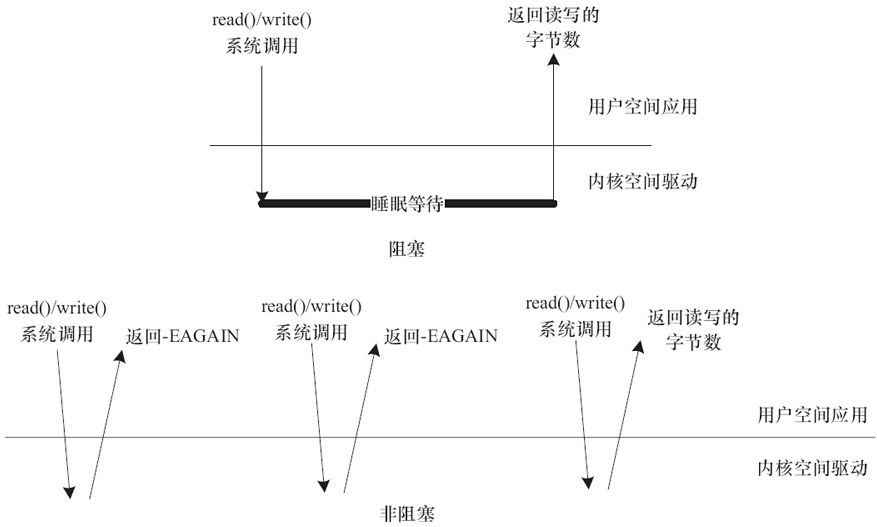简述
在Linux内核中,I/O操作可以是阻塞或非阻塞的。
阻塞I/O是指进程在进行I/O操作时会一直等待直到操作完成。在这种情况下,进程会被挂起,直到I/O操作完成。这种方式可以确保操作的完整性,但可能会导致进程长时间等待,从而影响应用程序的响应速度。
非阻塞I/O是指进程在进行I/O操作时不会一直等待,而是立即返回。如果I/O操作还没有完成,则进程可以继续执行其他操作。这种方式可以提高应用程序的响应速度,但可能会导致I/O操作不完整或错误。关系如下:

在Linux内核中,可以使用select、poll、epoll等系统调用来实现非阻塞I/O。这些系统调用可以监视多个文件描述符,并在其中任何一个变为“就绪”时通知进程。这样,进程可以在I/O操作完成之前继续进行其他操作,而不必一直等待。
阻塞I/O适用于需要确保操作完整性的情况,而非阻塞I/O适用于需要提高应用程序响应速度的情况。
应用如何设置
应用程序可以使用fcntl系统调用来设置文件描述符的属性,从而指定是阻塞还是非阻塞模式。
在阻塞模式下,应用程序可以使用如下代码将文件描述符设置为阻塞模式:
int flags = fcntl(fd, F_GETFL, 0);
fcntl(fd, F_SETFL, flags & ~O_NONBLOCK);
在非阻塞模式下,应用程序可以使用如下代码将文件描述符设置为非阻塞模式:
int flags = fcntl(fd, F_GETFL, 0);
fcntl(fd, F_SETFL, flags | O_NONBLOCK);
等待队列
在 Linux 内核中,等待队列是一种机制,用于在进程等待某些事件发生时进行同步。
当一个进程等待某些条件时,它会调用一个等待函数,例如 wait_event 或 wait_event_interruptible。这个函数会将进程添加到等待队列中,并将进程挂起,直到条件满足。当条件满足时,等待队列中的进程将被唤醒,并继续执行。
等待队列还可以使用信号量或读写信号量进行同步。当一个进程等待一个信号量时,它会将自己添加到等待队列中,并在信号量可用时被唤醒。类似地,当一个进程等待一个读写信号量时,它会将自己添加到等待队列中,并在读写信号量可用时被唤醒。
总之,等待队列是 Linux 内核中实现同步的重要机制之一。它们可以帮助进程等待某些条件,并在条件满足时进行同步。在编写内核代码时,理解等待队列的概念和用法非常重要。
等待队列在 Linux 内核中是通过 wait.h 头文件来定义和实现的。这个头文件包含了许多与等待队列相关的数据结构、函数和宏定义。
以下是一些 wait.h 头文件中常用的数据结构:
- wait_queue_head_t:等待队列头结构体,用于管理等待队列中的等待进程。
- wait_queue_t:等待队列项结构体,用于表示等待队列中的一个等待进程。
- wait_bit_queue_t:位等待队列项结构体,用于表示等待队列中的一个等待进程,它与位图相关。
以下是一些 wait.h 头文件中常用的函数:
- init_waitqueue_head(wait_queue_head_t *):初始化等待队列头。
- DECLARE_WAITQUEUE(name, current): 定义一个等待队列。
- add_wait_queue(wait_queue_head_t *, wait_queue_t *):将一个等待队列添加到等待队列头。
- remove_wait_queue(wait_queue_head_t *, wait_queue_t *):将等待队列从等待队列头中移除。
- wake_up(wait_queue_head_t *)
- wake_up_nr(wait_queue_head_t *, unsigned int mode)
- wake_up_all(wait_queue_head_t *)
- wake_up_locked(wait_queue_head_t *)
- wake_up_all_locked(wait_queue_head_t *)
- wake_up_interruptible(wait_queue_head_t *)
- wake_up_interruptible_nr(wait_queue_head_t *, unsigned int mode)
- wake_up_interruptible_all(wait_queue_head_t *)
- wake_up_interruptible_sync(wait_queue_head_t *)
- wait_event(wait_queue_head_t *, unsigned condition):等待条件(第二个参数)发生。
- wait_event_timeout(wait_queue_head_t *, unsigned condition):等待条件发生,但是在超时时间内没有发生时返回。
- wait_event_interruptible(wait_queue_head_t *, unsigned condition):等待条件发生,但是可以被信号中断。
- wait_event_interruptible_timeout(wait_queue_head_t *, unsigned condition):等待条件发生,但是可以被信号中断,并且在超时时间内没有发生时返回。
除了上述函数之外,wait.h 头文件还定义了许多与等待队列相关的宏定义,例如 wait_event_interruptible_exclusive()、wait_event_interruptible_exclusive_timeout() 等。
阻塞实现
定义和初始化:
wait_queue_head_t g_queue;
init_waitqueue_head(&g_queue);
unsigned int g_key = 0; /* 按键 0:没有 1:按键按下 */
进程唤醒
wake_up_interruptible(&g_queue);
进程挂起
使用等待队列+schedule()
if(filp->f_flags & O_NONBLOCK) {
if(g_key == 0)
ret = -EAGAIN;
goto out;
} else {
DECLARE_WAITQUEUE(wait, current); /* 定义一个等待队列 */
if(g_key == 0) {
add_wait_queue(&g_queue, &wait); /* 添加到等待队列头 */
__set_current_state(TASK_INTERRUPTIBLE);/* 设置任务状态 */
schedule(); /* 挂起进程 */
if(signal_pending(current)) { /* 判断是否为信号引起的唤醒 */
ret = -ERESTARTSYS;
goto wait_error;
}
set_current_state(TASK_RUNNING); /*设置为运行状态 */
remove_wait_queue(&g_queue, &wait); /*将等待队列移除 */
}
}
完全使用等待队列
if(filp->f_flags & O_NONBLOCK) {
if(g_key == 0)
ret = -EAGAIN;
goto out;
} else {
ret = wait_event_interruptible(g_queue, g_key);
}
wait_event_interruptible系列函数里面就是把schedule()函数封装了一层,所以我们在使用时可以直接使用wait_event_interruptible系列函数。
非阻塞
设备驱动中的轮询编程
设备驱动中poll()函数的原型是:
unsigned int(*poll)(struct file * filp, struct poll_table* wait);
第1个参数为file结构体指针,第2个参数为轮询表指针。这个函数应该进行两项工作。
-
对可能引起设备文件状态变化的等待队列调用poll_wait()函数,将对应的等待队列头部添加到poll_table中。
-
返回表示是否能对设备进行无阻塞读、写访问的掩码。
设备驱动中poll()函数的典型模板,如下所示
static unsigned int xxx_poll(struct file *filp, poll_table *wait)
{
unsigned int mask = 0;
struct xxx_dev *dev = filp->private_data; /* 获得设备结构体指针*/
...
poll_wait(filp, &dev->r_wait, wait); /* 加入读等待队列 */
poll_wait(filp, &dev->w_wait, wait); /* 加入写等待队列 */
if (...) /* 可读 */
mask |= POLLIN | POLLRDNORM; /* 标示数据可获得(对用户可读)*/
if (...) /* 可写 */
mask |= POLLOUT | POLLWRNORM; /* 标示数据可写入*/
...
return mask;
}
应用程序的轮询编程
应用程序中最广泛用到的是BSD UNIX中引入的select()系统调用,其原型为:
int select(int numfds, fd_set *readfds, fd_set *writefds, fd_set *exceptfds, struct timeval *timeout);
poll()的功能和实现原理与select()相似,其函数原型为:
int poll(struct pollfd *fds, nfds_t nfds, int timeout);
当多路复用的文件数量庞大、I/O流量频繁的时候,一般不太适合使用select()和poll(),此种情况下,select()和poll()的性能表现较差,我们宜使用epoll。epoll的最大好处是不会随着fd的数目增长而降低效率,select()则会随着fd的数量增大性能下降明显。
与epoll相关的用户空间编程接口包括:
struct epoll_event {
__uint32_t events; /* Epoll events */
epoll_data_t data; /* User data variable */
};
int epoll_create(int size);
int epoll_ctl(int epfd, int op, int fd, struct epoll_event *event);
int epoll_wait(int epfd, struct epoll_event * events, int maxevents, int timeout);
位于https://www.kernel.org/doc/ols/2004/ols2004v1-pages-215-226.pdf的文档《Comparing and Evaluating epoll,select,and poll Event Mechanisms》对比了select、epoll、poll之间的一些性能。一般来说,当涉及的fd数量较少的时候,使用select是合适的;如果涉及的fd很多,如在大规模并发的服务器中侦听许多socket的时候,则不太适合选用select,而适合选用epoll。